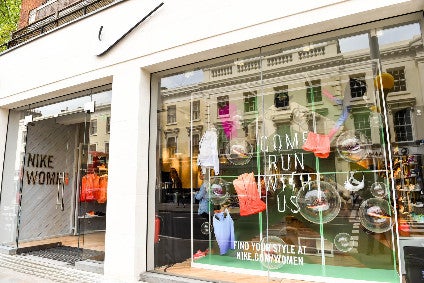
Sporting goods giant Nike Inc has been hit hard as store closures and a 38% drop in sales pushed it to a fourth-quarter loss – but is setting its sights on online growth as a key pillar for the future.
For the three months to 31 May, the company swung to a quarterly loss of $790m, compared with net income of $989m a year earlier, as lower revenue and gross margin were partially offset by a 6% drop in selling and administrative expenses.
Revenues fell 38% to $6.3bn, as 90% of physical owned stores were closed due to the Covid-19 pandemic. Sales in North America were down 46%, but sales in China were down just 3% as stores reopened ahead of other markets.
Product shipments to wholesale customers fell nearly 50%. However, online sales jumped 75% to reach around 30% of total revenue, with “strong double-digit increases” across all geographies as shoppers sought out trainers and fitness wear.
Gross margin fell 820 basis points to 37.3% as higher full-price sales were more than offset by a rise in product costs including factory cancellation charges, increased inventory obsolescence reserves, and the adverse rate impact of supply chain fixed costs on lower wholesale shipments. On a unit basis, the company cancelled around 30% of its pre-Covid-19 factory purchase orders for the autumn and holiday seasons.
During the quarter, Converse brand revenues dropped 38%, while the Nike brand saw footwear sales down 35%, apparel fell 42% and equipment revenue tumbled 53%.

US Tariffs are shifting - will you react or anticipate?
Don’t let policy changes catch you off guard. Stay proactive with real-time data and expert analysis.
By GlobalDataFor fiscal 2020, revenues fell 4% to $37.4bn, with digital sales up 47%, and Greater China revenues increasing 8%.
Net income for the year fell 37% to $2.5bn from $4.03bn, and gross margin was down 130 basis points to 43.4%. Weighing on margin and profits were higher product costs including tariffs in the US, factory cancellation charges, and higher expenses for shipping and returns.
The Beaverton, Oregon based company ended the year with a 31% hike in inventories to $7.4bn.
90% of Nike-owned stores have now reopened across the globe, and “retail traffic continues to improve week-over-week with higher conversion rates as compared to the prior year,” according to the company
“In a highly dynamic environment, the Nike brand continues to resonate strongly with consumers all over the world as our digital business accelerates in every market,” said John Donahoe, president and CEO.
“We are uniquely positioned to grow, and now is the time to build on Nike’s strengths and distinct capabilities. We are continuing to invest in our biggest opportunities, including a more connected digital marketplace, to extend our leadership and fuel long-term growth.”
“As physical retail re-opens, Nike’s strong digital trends continue, a testament to the strength of our brand and the investments we’ve made to elevate digital consumer experiences,” added Matt Friend, executive vice president and chief financial officer.
Digital acceleration
Setting out the company’s plans for the future, Donahoe told analysts the company is now aiming for e-commerce sales to account for 50% of overall sales in the foreseeable future. It has accelerated its goal after a previous target for 30% digital penetration by 2023 looks set to be reached this coming year – more than two years early.
The new ‘Consumer Direct Acceleration’ is the “digitally empowered phase of our Consumer Direct strategy” and aims to create “a clear and connected digital marketplace…more closely aligned with what consumers want and need.
“Consumers want modern, seamless experiences, online to offline, so we’re accelerating our approach. Connected data, inventory and membership will give consumers greater access to the best of Nike with more speed and convenience than ever.” Mono-brand stores with integrated online-to-offline capabilities in areas like women’s and apparel are seen as key to driving long-term profitability.
Nike also plans to operate under a new, simplified approach. “We know that our consumers don’t see themselves as only runners or yoga practitioners. They don’t think in terms of performance versus sportswear. Instead we know how they shop across men’s, women’s and kid’s, and so we’ll realign the company to reflect” this.
“This approach allows us to better focus on the individual consumer and unlock new opportunities to more nimbly serve their exact needs,” Donahoe said.
Friend added: “On average, a sale of an incremental unit via digital generates double the revenue versus a sale to wholesale with a higher gross margin, translating into two times the operating income dollars.”




